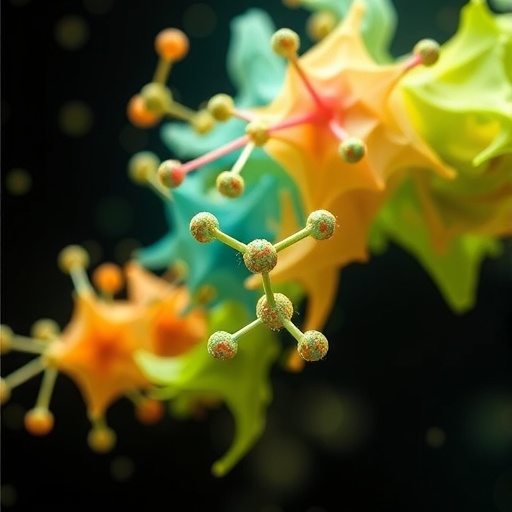
In a groundbreaking study, researchers have unveiled a novel method for synthesizing NiFeâOâ nanoparticles using the seeds of Guizotia abyssinica, a plant known for its nutritional and medicinal properties. This innovative approach not only promises efficiency in nanoparticle production but also highlights the potential of biological materials in nanotechnology. The seamless integration of sustainable resources in cutting-edge science is a crucial step toward greener manufacturing processes in materials science.
NiFeâOâ is a mixed metal oxide that has garnered substantial interest in recent years due to its unique magnetic, electronic, and catalytic properties. These features make it particularly appealing for various applications, including photocatalysis, which is a process that uses light to accelerate chemical reactions. The development of efficient photocatalysts is essential for advancements in areas such as environmental remediation, energy conversion, and sustainable chemical processes.
The researchers’ choice to employ Guizotia abyssinica seeds as a biosynthetic source is noteworthy. This plant, often referred to as niger seed, is not only abundant but also relatively inexpensive, making it an attractive alternative to traditional chemical synthesis methods. By utilizing agricultural waste, the study aligns with the principles of a circular economy, promoting the utilization of renewable resources while minimizing environmental impact.
The biosynthesis process involves the extraction of plant metabolites, which play a pivotal role in the reduction and stabilization of metal ions. This natural pathway allows for a more controlled synthesis environment, potentially leading to more consistent particle size and morphology compared to conventional methods. The researchers meticulously optimized the reaction conditions, tweaking parameters such as temperature and pH, to achieve the desired properties in the resulting nanoparticles.
Photocatalytic dye degradation represents a significant application of NiFeâOâ nanoparticles. Dyes, often used in textile and manufacturing processes, pose substantial environmental challenges due to their toxic and persistent nature. The deployment of efficient photocatalysts can facilitate the breakdown of these complex molecules into harmless byproducts, thereby addressing pollution levels in water bodies. This aspect alone underscores the relevance of the study in real-world environmental remediation efforts.
Furthermore, the researchers conducted extensive characterization of the synthesized NiFeâOâ nanoparticles, employing techniques such as X-ray diffraction (XRD), scanning electron microscopy (SEM), and energy-dispersive X-ray spectroscopy (EDX). These analyses revealed critical insights into the crystalline structure, particle size, and elemental composition, confirming the successful synthesis of high-purity nanoparticles. The meticulous attention to detail in these characterizations adds credibility to the findings and opens avenues for further research.
The studyâs implications extend beyond photocatalysis. NiFeâOâ nanoparticles are also being explored for use in energy storage applications, such as lithium-ion batteries and supercapacitors. The unique properties of these nanoparticles enable them to exhibit high electrical conductivity and electrochemical activity, which are essential for efficient charge and discharge cycles. This dual application underscores the versatility of the synthesized nanoparticles, making them valuable in both environmental and energy sectors.
Additionally, the researchers conducted comparative studies with NiFeâOâ synthesized through traditional chemical methods, highlighting the advantages of biosynthesis. The results indicated that the nanoparticles derived from Guizotia abyssinica seeds exhibited superior photocatalytic activity, demonstrating the potential of plant-based approaches in the field of nanomaterials. This revelation is a testament to the capabilities of nature in aiding technological advancements.
As the world grapples with pressing environmental issues, the integration of green chemistry principles in nanoparticle synthesis offers a hopeful outlook. By employing biogenic methods, researchers are paving the way for sustainable solutions that align with global sustainability goals. The focus on environmentally friendly practices resonates with both scientific communities and the general public, making such studies highly relevant in contemporary discourse.
Looking ahead, the researchers envision further exploration into the functionalization of NiFeâOâ nanoparticles. By modifying their surface properties or incorporating additional components, the nanoparticles could be tailored for specific applications beyond photocatalysis. This adaptability underscores the dynamic nature of nanotechnology and encourages ongoing research in the field.
In conclusion, the swift biosynthesis of NiFeâOâ nanoparticles from Guizotia abyssinica seeds exemplifies a noteworthy advancement in material science. As these findings progress from laboratory to application, they hold potential for making a meaningful impact on both environmental and energy challenges faced by society today. The fusion of traditional knowledge and modern technology illuminates a path forward, enhancing our understanding and utilization of the bounties of nature in innovative scientific endeavors.
By harnessing the power of plant-based materials, the future of nanotechnology looks increasingly green. As researchers continue to explore the myriad possibilities of biogenic synthesis, the potential for groundbreaking discoveries remains vast, with the promise of fostering not only innovation but also sustainability in the scientific landscape.
Subject of Research: Biosynthesis of NiFeâOâ nanoparticles from Guizotia abyssinica seeds
Article Title: Swift biosynthesis of NiFeâOâ nanoparticles from Guizotia abyssinica seeds for superior photocatalytic dye degradation
Article References: G.R, G., Pavan, Udayabhanu et al. Swift biosynthesis of NiFe2O4 nanoparticles from Guizotia abyssinica seeds for superior photocatalytic dye degradation. Ionics (2025). https://doi.org/10.1007/s11581-025-06632-3
Image Credits: AI Generated
DOI: https://doi.org/10.1007/s11581-025-06632-3
Keywords: NiFeâOâ nanoparticles, photocatalysis, Guizotia abyssinica, sustainable materials, green chemistry, biosynthesis, environmental remediation
Tags: agricultural waste in nanotechnologybiodegradable materials in sciencecircular economy in materials scienceEco-friendly nanoparticle synthesisenvironmental remediation techniquesgreen manufacturing processesGuizotia abyssinica seedsinnovative biosynthetic methodsNiFe2O4 nanoparticlesphotocatalysis for dye degradationrenewable resource utilizationsustainable nanotechnology




